
Fra Angelico was an Italian painter of the Early Renaissance, described by Vasari in his Lives of the Artists as having "a rare and perfect talent". He earned his reputation primarily for the series of frescoes he made for his own friary, San Marco, in Florence.

Fra Bartolomeo or Bartolommeo, also known as Bartolommeo di Pagholo, Bartolommeo di S. Marco, and his original nickname Baccio della Porta, was an Italian Renaissance painter of religious subjects. He spent all his career in Florence until his mid-forties, when he travelled to work in various cities, as far south as Rome. He trained with Cosimo Rosselli and in the 1490s fell under the influence of Savonarola, which led him to become a Dominican friar in 1500, renouncing painting for several years. Typically his paintings are of static groups of figures in subjects such as the Virgin and Child with Saints.

The Patriarchal Cathedral Basilica of Saint Mark, commonly known as St Mark's Basilica, is the cathedral church of the Roman Catholic Patriarchate of Venice; it became the episcopal seat of the Patriarch of Venice in 1807, replacing the earlier cathedral of San Pietro di Castello. It is dedicated to and holds the relics of Saint Mark the Evangelist, the patron saint of the city.

The Gallerie dell'Accademia is a museum gallery of pre-19th-century art in Venice, northern Italy. It is housed in the Scuola della Carità on the south bank of the Grand Canal, within the sestiere of Dorsoduro. It was originally the gallery of the Accademia di Belle Arti di Venezia, the art academy of Venice, from which it became independent in 1879, and for which the Ponte dell'Accademia and the Accademia boat landing station for the vaporetto water bus are named. The two institutions remained in the same building until 2004, when the art school moved to the Ospedale degli Incurabili.
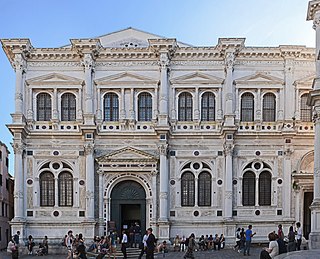
The Scuola Grande di San Rocco is a building in Venice, northern Italy. It is noted for its collection of paintings by Tintoretto and generally agreed to include some of his finest work.

The Scuola Grande di San Marco is a building in Venice, Italy, designed by the well-known Venetian architects Pietro Lombardo, Mauro Codussi, and Bartolomeo Bon. It was originally the home to one of the Scuole Grandi of Venice, or six major confraternities, but is now the city's hospital. It faces the Campo Santi Giovanni e Paolo, one of the largest squares in the city.
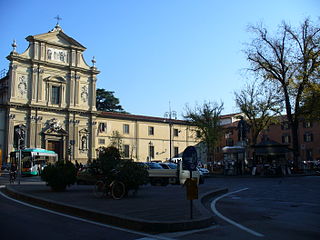
Museo Nazionale di San Marco is an art museum housed in the monumental section of the medieval Dominican friary dedicated to St Mark, situated on the present-day Piazza San Marco, in Florence, a region of Tuscany, Italy.
Giuliano di Piero di Simone Bugiardini was an Italian Renaissance painter. He was born and was mainly active in Florence. He was a painter primarily of religious subjects but he also executed a number of portraits and a few works with mythological subjects.

Sister Plautilla Nelli (1524–1588) was a self-taught nun-artist and the first known female Renaissance painter of Florence. She was a nun of the Dominican convent of St. Catherine of Siena located in Piazza San Marco, Florence, and was heavily influenced by the teachings of Savonarola and by the artwork of Fra Bartolomeo.
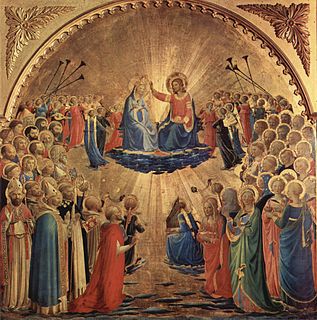
The Coronation of the Virgin is a painting of the Coronation of the Virgin by the Italian early Renaissance painter Fra Angelico, executed around 1432. It is now in the Uffizi Gallery of Florence. The artist executed another Coronation of the Virgin, now in the Louvre in Paris.

The Barbadori Altarpiece is a painting by Filippo Lippi, dated to 1438 and housed in the Louvre Museum of Paris.
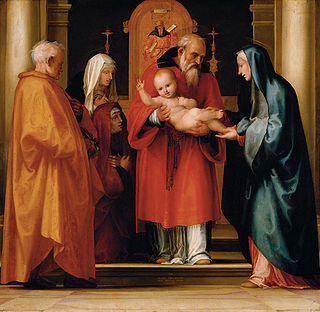
Presentation of Christ in the Temple is an oil on wood painting by Fra Bartolomeo, most likely commissioned by Pope Leo X for the Epiphany of 1516. It originally hung in the novices' chapel in San Marco, Florence. It is inscribed with the year 1516. It is now held in the Kunsthistorisches Museum in Vienna.

Assumption of the Virgin with Saint John the Baptist and Saint Catherine of Alexandria is an oil on panel painting by Fra Bartolomeo, created c. 1516, commissioned by the church of Santa Maria in Castello in Prato. To the left of the Virgin's tomb is John the Baptist, whilst to the right is Catherine of Alexandria. It is now in the National Museum of Capodimonte in Naples.
Silvana Grasso is an Italian writer.

Minerva is a c. 1490-1495 oil on panel painting by Fra Bartolomeo, now in the Louvre in Paris. It forms a pair with Porcia (Uffizi).

The San Gallo Annunciation is an oil on panel painting by Andrea del Sarto, executed c. 1513–1514, now in the Palatine Gallery in Florence.
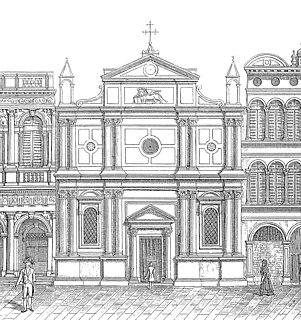
San Geminiano was a Roman Catholic church located in Piazza San Marco in Venice, Italy, dedicated to Saint Geminianus. It is believed to have been founded by the Byzantines in the 6th century AD and it was destroyed and rebuilt several times over subsequent centuries. The last reconstruction began in 1505 to designs of the architect Cristoforo da Legname, and it was completed by Jacopo Sansovino in 1557. This church was a significant example of Venetian Renaissance architecture, and it was well-known for being ornate and richly decorated. The building was demolished in 1807 in order to make way for the Napoleonic wing of the Procuratie, and many of the artworks it contained were distributed among other churches and museums.
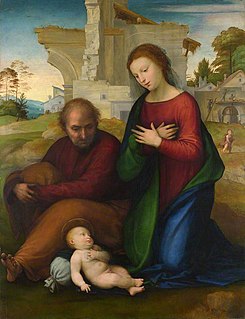
The Virgin Adoring the Child with Saint Joseph is an oil on panel painting by Fra Bartolomeo, executed no later than 1511. It is held in the National Gallery, in London.
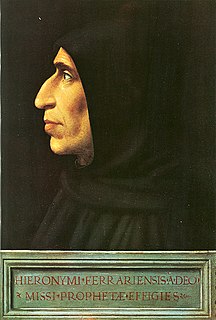
The Portrait of Girolamo Savonarola is an oil on panel painting by Italian artist Fra Bartolomeo, created c. 1498. This portrait is believed to have been made when reformer Girolamo Savonarola was still alive and when Fra Bartolomeo was a follower of his renewal religious movement in Florence. It is held at the Museo di San Marco, in Florence.

Apparition of the Virgin to St Bernard is an oil on wood painting by Italian artist Fra Bartolomeo, datable to 1504-1507. It is held in the Uffizi, in Florence.


















